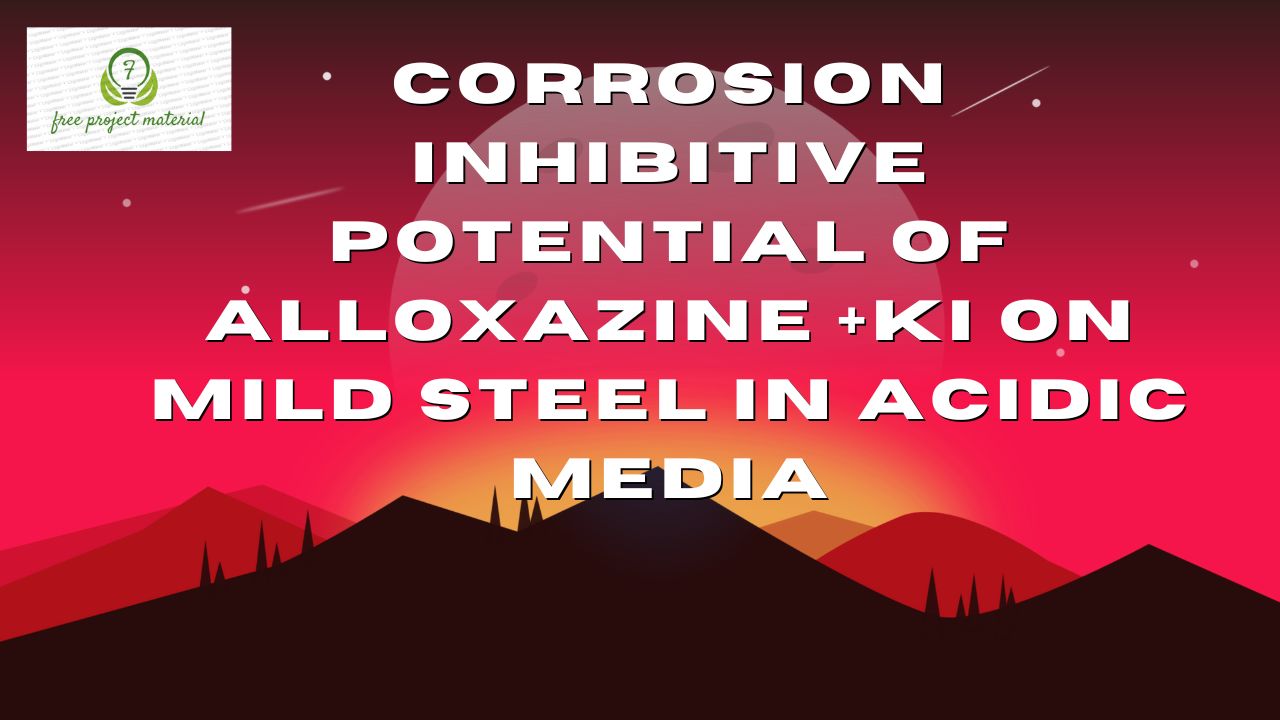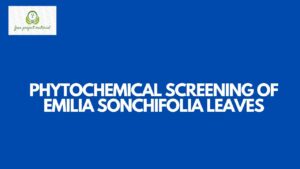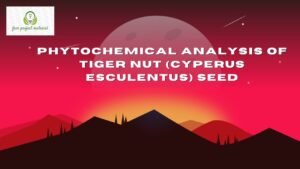ABSTRACT
The inhibition of mild steel in 0.1M HCl solution using gravimetric method. The result obtained showed that alloxazine +KI is a good inhibitive of mild steel corrosion in HCl solution. The inhibition efficiency increased by 49% with increase in the inhibitor concentration of 10 x104MmKI. Physical absorption has been proposed for the absorption of the organic compound on the mild steel surface.
TABLE OF CONTENT
PAGES
TITLE PAGE – – – – – – – – i
CERTIFICATION – – – – – – – – ii
DEDICATION – – – – – – – – iii
ACKNOWLEDGEMENTS – – – – – – iv
ABSTRACT – – – – – – – – v
TABLE OF CONTENT – – – – – – – vi-vii
CHAPTER ONE
INTRODUCTION
1.1 Background of the Study – – – – – – 1-2
1.2 Aim and Objectives of the Study – – – – 3
1.3 Scope and Limitation of the Study – – – – 3-4
1.4 Definition of Terms – – – – – – 4
CHAPTER TWO
2.0 LITERATURE REVIEW – – – – – 5-10
2.1 Types of Corrosion – – – – – – 10
2.1.1 Galvanic Corrosion – – – – – – 10
2.1.2 Pitting Corrosion – – – – – – – 11
2.1.3 Crevice Corrosion – – – – – – – 11-12
2.1.4 High Temperature Corrosion – – – – – 12-13
2.1.5 Microbial Corrosion – – – – – – 13-14
2.2 Protection From Corrosion – – – – – 14
2.2.1 Surface Treatment – – – – – – – 14
2.2.2 Applied Coatings – – – – – – – 15
2.2.3 Reactive Coatings – – – – – – – 15-16
2.2.4 Anodization – – – – – – – – 16
2.2.5 Biofilm Coatings – – – – – – – 16
2.3 Economic Impact of Corrosion – – – – – 17-18
CHPATER THREE
3.0 MATERIALS AND METHOD
3.1 Materials – – – – – – – – 19
3.1.1 Materials Collection – – – – – – 19
3.2 Method – – – – – – – 20
3.2.1 Specimen Preparation – – – – – – 20
3.2.2 Gravimetric Method – – – – – – 20-21
CHAPTER FOUR
4.0 RESULT AND DISCUSSION
4.1 Results – – – – – – – – 22-24
4.2 Effects of Studied Inhibitor on Weight Loss – – – 25
4.3 Corrosion Rate and Inhibition Efficiency – – – 25
CHAPTER FIVE
5.0 CONCLUSION AND RECOMMENDATION
5.1 Conclusion – – – – – – – – 26
5.2 Recommendation – – – – – – – 26
References
CHAPTER ONE
INTRODUCTION
1.1 Background of the Study
In practice, corrosion can never be stopped but can be hindered to a reasonable level. Over the years, reductions in the rate of metal corrosion have been achieved through a number of ways. It involved controlling the pH or ion concentration of the solution or controlling the metal solution interface. This is achieved through the addition of small amount of chemicals called inhibitors, that either form a barrier like layer on the metal surface or stimulate film formation and by so doing retard or slow down the rate of metal dissolution (Khaled, 2006). Acid solutions are widely used in industry. Some important fields of application include acid pickling of iron and steel, chemical cleaning and processing, ore production and oil well acidification. Acids such as HCl are generally used in the treatment of steel and ferrous alloys. Because of the general aggression of acid solutions, inhibitors are commonly used to reduce the corrosive attack on metallic materials.
Among many methods of corrosion control and prevention, the use of organic inhibitors is the most frequent used. Some researchers have shown that most of the efficient organic inhibitors contain nitrogen, oxygen, sulphur, double and triple bonds, so there is some lone pair of electrons and π bonds existing in their molecules which serve as adsorption sites (Obot and Obi-Egbedi, 2008). Moreover, many N-heterocyclic compounds have been used as effective inhibitors for the corrosion of metals and alloys in aqueous media (Chetouani et al., 2005). Unfortunately most of the organic inhibitors are toxic, very expensive and environmentally unfriendly. Due to increasing environmental awareness and adverse effect of some chemicals, research activities in recent times are geared towards developing cheap, non-toxic and environmentally acceptable corrosion inhibitors (Obot et al., 2009).
1.2 Aim and Objectives of the Study
The aim of this study was to determine the corrosion inhibitive potential for mild steel in
0.1M HCl.
Objectives:
- To investigate the corrosion inhibitive potential for mild steel in HCl solution by weight loss method.
- To study the effect of different concentration of acid on the corrosion inhibitive of mild steel.
1.3 Scope and Limitation of the study
The research covers the corrosion inhibitive potential of mild steel in 0.1M HCl solution
The limitations encountered in the course of this study are;
- Financial constraints
- Time constraints
- Poor power supply
1.4 Definition of Terms
Corrosion: corrosion is the deterioration of a material usually metal due to interaction with its environments.
Mild Steel: Mild steel is the least expensive of all steel and the most common steel used. It contains a maximum of 0.29% carbon, these types of steel able to be magnetized and used in almost any project that requires a vast amount of metal.



